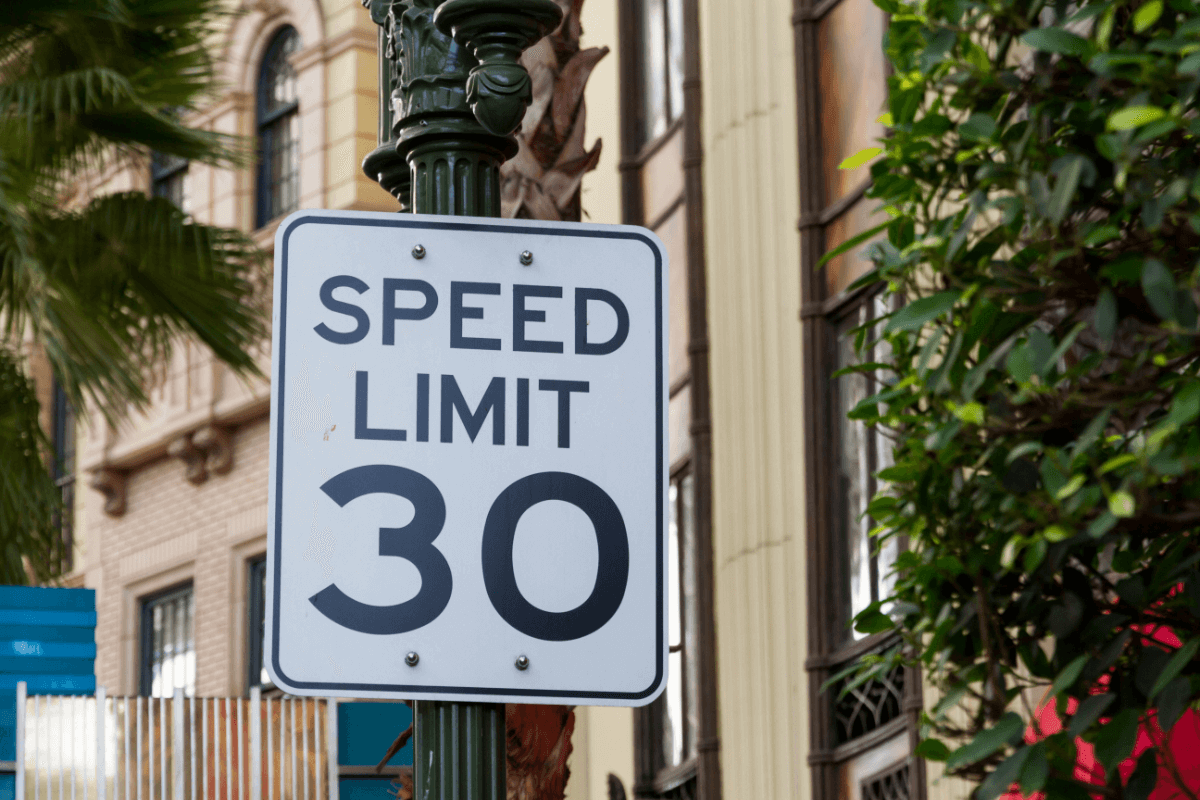California’s Basic Speed Law Explained (2024)

We know many people are confused by California’s Basic Speed Limit law. Our car accident lawyers deal with speeding related car accidents on a regular basis.
That’s why in this blog post, we explain California’s basic speed law in detail.
We’ll explain what Absolute and Prima Facie speed limit laws are, and include examples of how the law changes in different driving conditions. This will include school zones, construction zones, and more.
Let’s begin.
Vehicle Code 22350 is commonly known as California’s basic speeding law. It is the law requiring drivers to operate their vehicles at reasonable, safe speeds under normal conditions.
However, the meaning of “safe” and “reasonable” can change with driving conditions. Rain, rush-hour traffic, or changes in road conditions may all be valid reasons to reduce speed.
Under the basic speeding law, drivers must adjust their speeds based on these and other conditions:
- The presence of pedestrians or bicyclists
- The presence of animals
- Proximity to railroad crossing
- Slippery or wet road surfaces
- Reduced visibility, such as from fog, smog, smoke, other natural conditions, or other view obstructions
- Sun glare, excessive sunlight, or the presence of other bright lights
- Traffic congestion
Here’s what the basic speeding law comes down to:
Drivers must make necessary speed adjustments when traveling in all conditions. Whether in crowded city areas, business districts, residential streets, remote and rural areas, or when driving over a hill.
For example:
Drivers must be aware that driving at 65 mph on a freeway may be allowable on a clear morning, but would be a violation of the law in other conditions.
Absolute Speed Limit and “Prima Facie”
When drivers break absolute speed limits, they automatically violate speed limit laws. Absolute speed limits prohibit drivers from operating their vehicles at speeds higher than those permitted by law.
Freeway and Highway Speed Limits
Under Vehicle Code 22356, California’s drivers must obey the following speed limits:
- 70 miles per hour (mph) on freeways marked with this rate
- 65 mph on freeways or other highways not marked with the 70 mph limit
- 55 mph on undivided highways with two lanes unless these highways have higher speed limits posted
Drivers exceeding these limits are automatically recognized as speeding and in violation of the vehicle code under these “absolute” limits.
Construction Zone Speed Limits
It is also illegal for drivers to speed in construction zones under Vehicle Code 22362. Often construction zones have specific speed limits posted, sometimes as low as 25 mph. If drivers exceed the limit within 400 feet of a construction zone, they can be charged with a violation of this code.
Prima Facie Speed Limits
California also has prima facie speed limits. These “presumed” limits are established in Vehicle Code 22352.
Under this law, unless otherwise posted, drivers must obey the prima facie speed limits. Driving over the limit in prima facie areas does not come with an automatic violation.
Railroad Crossing Limits
- 15 mph at railroad crossings, while driving through alleys, and in highway intersections that do not allow 100 feet of visibility for approaching vehicles
Residential Speeding Limits
- 25 mph in residential and business districts
School Zone Limits and Senior Center Limits
- 25mph “when approaching or passing a school building or grounds,” or when “passing a senior center or another facility primarily used by senior citizens”
California’s Minimum Speed Limit Laws
Too-slow drivers can cause those around them to have to slam on their brakes, swerve to avoid a collision, and create other dangerous scenarios. California’s minimum speed limit laws work to prevent these situations, specifically through Vehicle Code 22400, included in California’s “other speed laws.”
This law states drivers cannot drive so slowly that they block or slow the regular flow of traffic.
The reduced speed is only allowed if it is necessary for safely operating the vehicle, navigating the road grade, or complying with the law. The minimum speed law also prohibits drivers from stopping on a highway unless they need to in order to safely operate the vehicle or to comply with the law.
Determining whether a driver’s speed is so slow as to incur a violation requires consideration of the specific circumstances, including:
- The maximum speed limit, as posted
- Weather conditions
- Traffic conditions
- Roadway and driving conditions
- The number of lanes on the highway
- The time of day
Speed-Related Accident Facts (NHTSA)
 The National Highway Traffic Safety Administration (NHTSA) classifies accidents as speed-related if any driver in the accident is charged with a speed-related offense. Typically, the police officers will make a note if they determine the driver was engaging in racing, driving too fast for the existing conditions, or going over the posted speed limit.
The National Highway Traffic Safety Administration (NHTSA) classifies accidents as speed-related if any driver in the accident is charged with a speed-related offense. Typically, the police officers will make a note if they determine the driver was engaging in racing, driving too fast for the existing conditions, or going over the posted speed limit.
NHTSA data shows over the recent year, speed-related factors contributed to:
- 28% of fatal crashes, producing 12,330 deaths and representing an 8% increase from the previous year
- 13% of injury-involved crashes, leaving 328,946 injured victims
- 9% of property-damage-only accidents
Across the nation, speed issues accounted for 29% of all traffic fatalities. California ranked second-highest (after Texas) for the number of speed-involved fatalities, recording 1,509 deaths. California reported 4,285 traffic accident fatalities, with speed contributing to 35% of them.
When someone else violates a speeding law and leaves you or someone you love injured or killed, you deserve serious compensation. The California car accident lawyers at Curtis Legal Group are “heavy hitters” and will fight tirelessly to get you the financial and emotional justice you need to recover and move forward. Call or send a message to set up a free consultation with an experienced, compassionate, and bold attorney who will manage your case with skill from start to finish.
